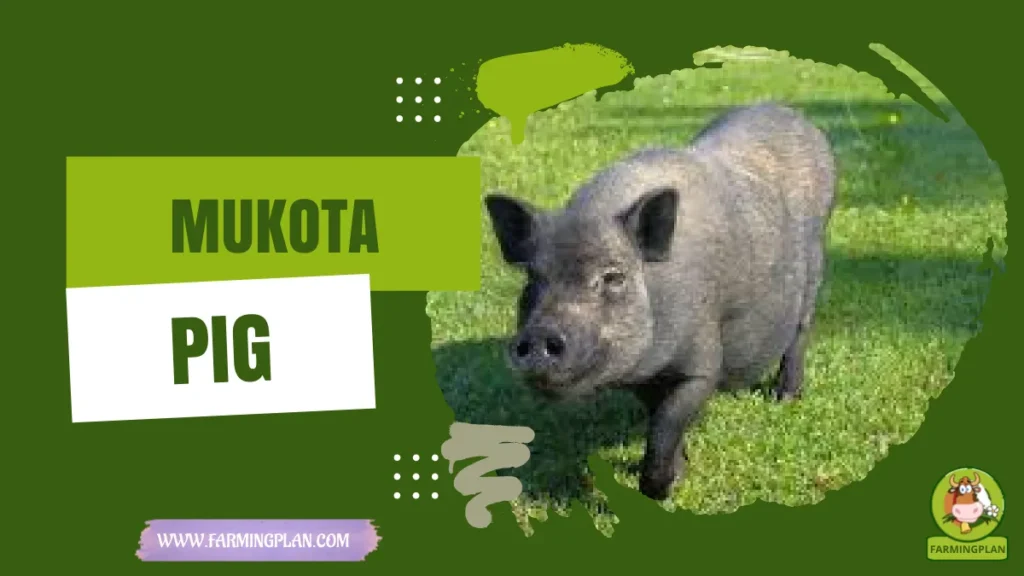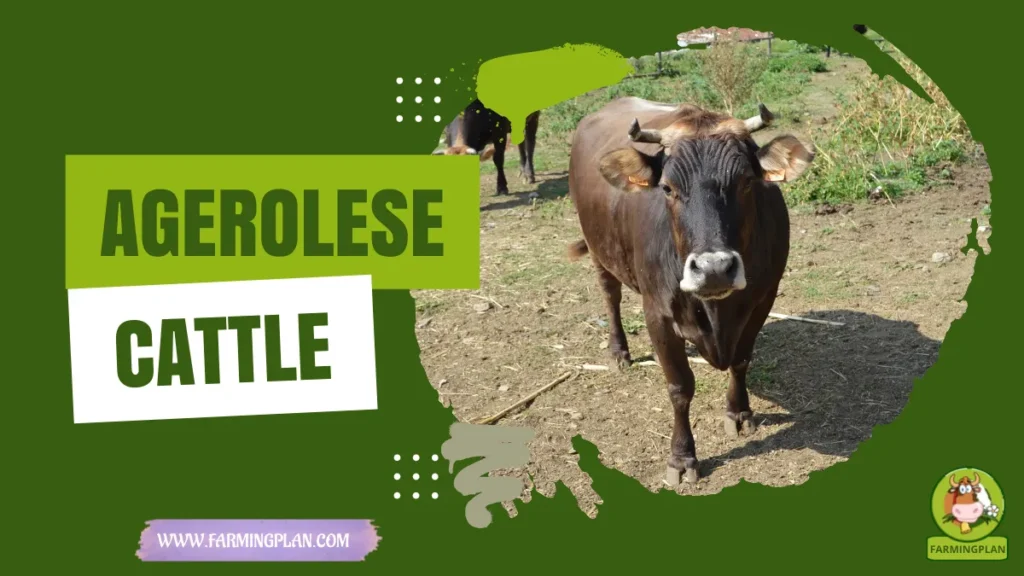If you’re looking for a goat that’s beautiful, easygoing, and gives you top-tier milk, let me introduce you to the Oberhasli goat. I’ve raised a few in my time, and they’ve quickly become one of my favorite breeds to work with. These reddish-brown beauties with striking black markings aren’t just a treat to look at—they’re calm, hardworking, and make fantastic dairy animals. Whether you’re a first-time goat owner or a seasoned farmer, Oberhaslis bring a unique blend of charm and productivity to your herd. From their Alpine origins to their role as dependable pack animals and milk producers, these goats truly do it all. I’ll cover their history, care, and why every yard needs an Oberhasli.
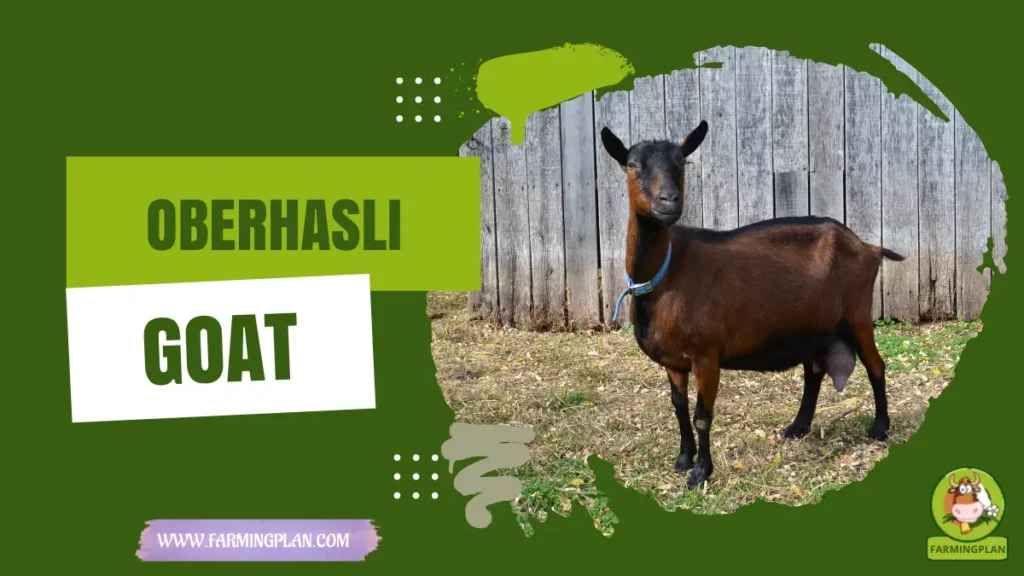
History & Origin of the Oberhasli Goat
The Oberhasli goat comes from the mountainous regions of Switzerland, where they were known as Chamois Colored Goats. These goats were hardy by nature, built to handle rocky trails, cold temps, and less-than-perfect weather something that still makes them a great fit for farms across North America today. Their rich reddish-brown coats with black stripes helped them blend into the Swiss Alpine terrain, but thankfully, their legacy didn’t stay hidden in the hills.
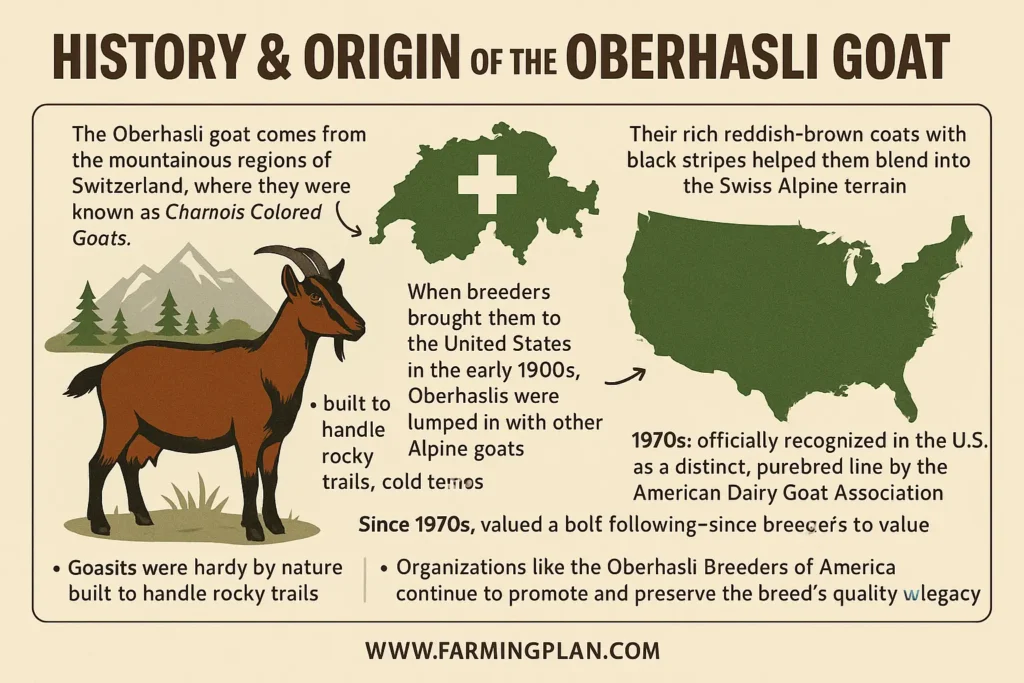
When breeders brought them to the United States in the early 1900s, Oberhaslis were lumped in with other Alpine goats at first. But by the 1970s, folks realized they deserved their own spotlight. That’s when the breed was officially recognized in the U.S. as a distinct, purebred line by the American Dairy Goat Association. Since then, they’ve gained a solid following—especially among breeders who value both form and function. Today, organizations like the Oberhasli Breeders of America continue to promote and preserve the breed’s quality and legacy.
Oberhasli Goat Characteristics: Appearance & Coat Colors
One of the first things people notice about the Oberhasli goat is that striking coat. They’ve got a deep reddish-brown body—often called “bay”—with sharp black facial stripes, a black dorsal stripe (aka “mule stripe”), and dark markings on their legs and belly. Bucks tend to have darker, more pronounced markings than does, and some even have goat wattles, which always get a few laughs from visitors at the farm.
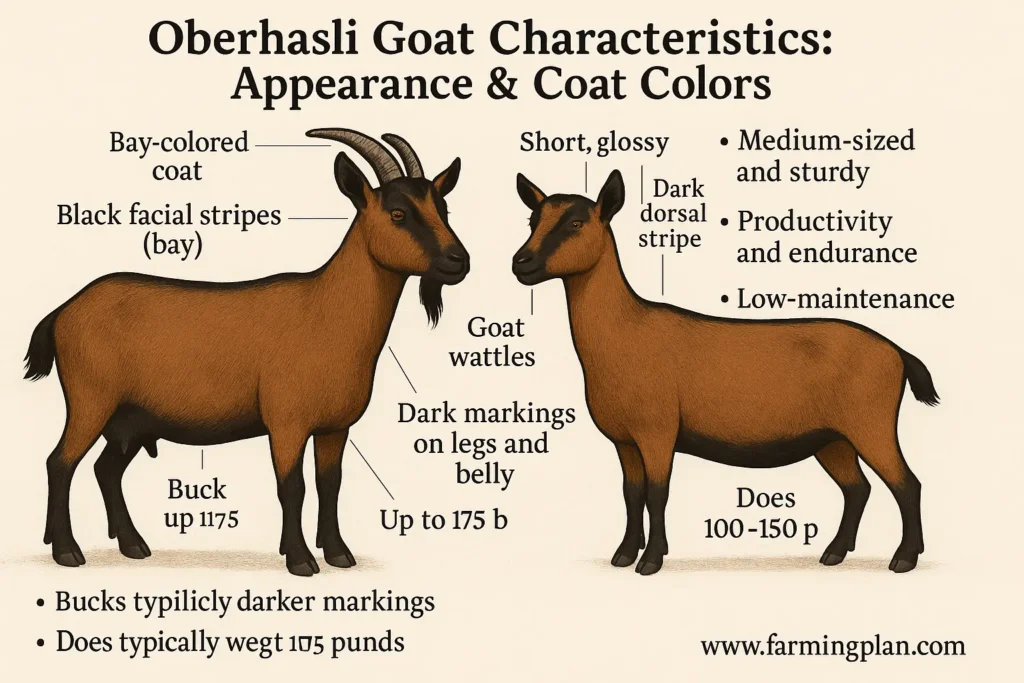
They’re a medium-sized breed, typically weighing 100–150 pounds for does and up to 175 for bucks. But don’t let their size fool you—these goats are sturdy and built for both productivity and endurance. Their short, glossy coat not only makes them low-maintenance when it comes to grooming, but also helps them stay comfortable in various climates. When it comes to looks and performance, Oberhaslis check both boxes without breaking a sweat.
Read More: Barbari Goat: Hardy Breed With Great Milk And Meat
Temperament & Personality: The Calm Nature of Oberhasli Goats
Temperament is where the Oberhasli goat really shines. I’ve raised a lot of goats over the years, but these guys? They’re calm, polite, and smart. They’ve got this gentle disposition that makes them perfect for families with kids, new goat owners, or anyone who’s tired of chasing rowdy animals around the yard. Even the bucks, which can be a handful in some breeds, are fairly easy to manage especially outside of rut season.
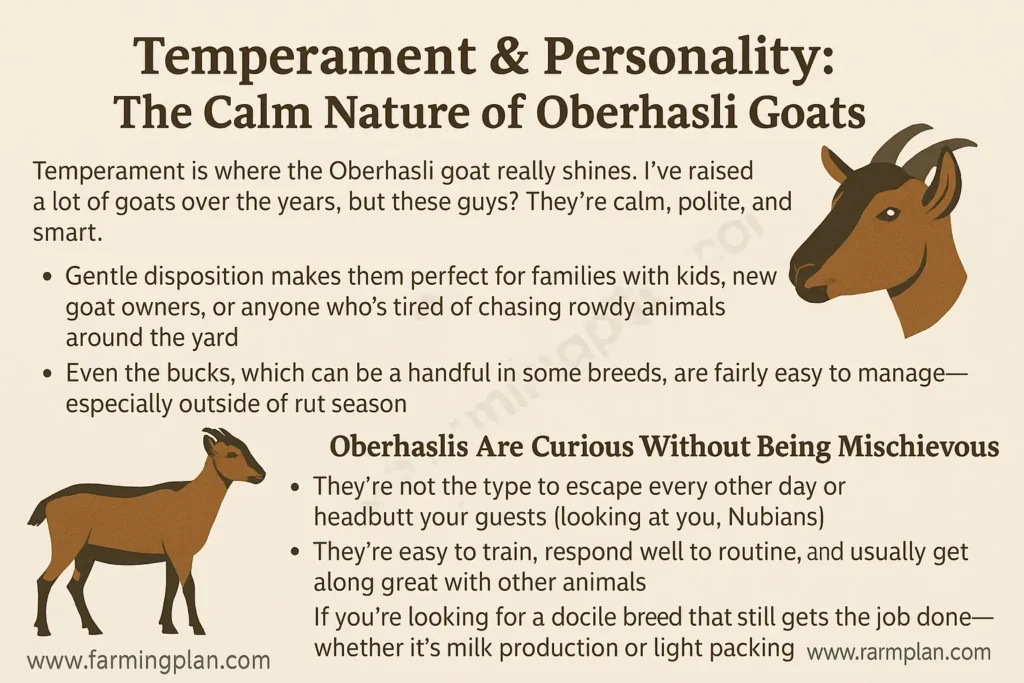
Oberhaslis are curious without being mischievous. They’re not the type to escape every other day or headbutt your guests (looking at you, Nubians). They’re easy to train, respond well to routine, and usually get along great with other animals. If you’re looking for a docile breed that still gets the job done whether it’s milk production or light packing—these goats have the personality to match their looks.
Feeding Oberhasli Goats: Diet Tips & Nutritional Needs
Feeding Oberhasli goats isn’t complicated, but you do want to make sure they get the right mix of nutrition to stay healthy and productive. A good foundation is quality hay—alfalfa is ideal for milking does thanks to the higher calcium and protein. Add in some goat grain (but not too much), especially if you’re trying to boost milk production or keep bucks in top shape during breeding season.
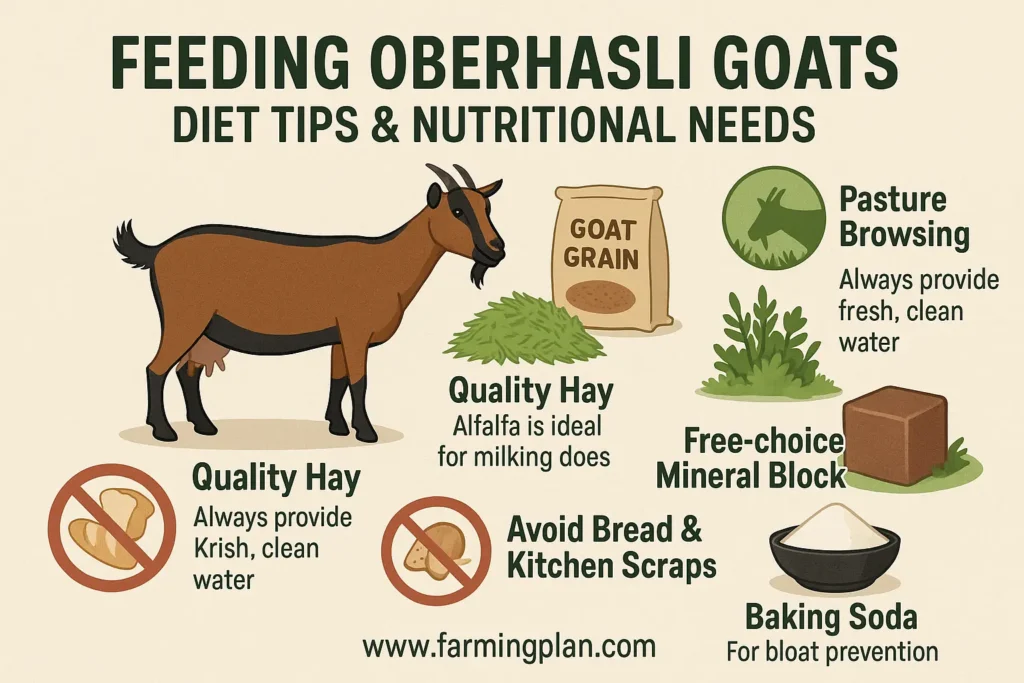
These goats also thrive on pasture browsing, which helps balance their diet naturally. Make sure they’ve always got access to fresh, clean water and a free-choice mineral block designed for goats. I stay away from feeding too many kitchen scraps or bread—goats love them, but their digestive systems don’t. And don’t forget to offer baking soda on the side; it helps with bloat prevention, especially when they’re munching on rich feeds.
Read More: Australian Miniature Goat: Farming Practical
Purpose & Uses: What Are Oberhasli Goats Good For?
Oberhaslis are best known as a dairy goat breed, and for good reason. A well-fed doe can give up to 2 gallons of milk a day during peak season. The milk is sweet, smooth, and not too “goaty” perfect for cheese, yogurt, or your morning coffee. They also have a reputation for consistent production across longer lactation periods compared to some other breeds.
But that’s not all. Thanks to their sturdy build and calm personality, Oberhaslis also make excellent pack goats. I’ve taken a couple on long hikes, and they handled rough trails, water crossings, and campfire naps like seasoned pros. They’re also popular for 4-H projects, show rings, and as gentle companions on family farms. Whether you need milk, muscle, or mellow vibes—this breed delivers.
Special Features That Make Oberhasli Goats Stand Out
Beyond their good looks and sweet nature, Oberhaslis have some special traits that set them apart. For starters, their exceptional dairy production isn’t just about volume it’s about consistency and quality. These goats keep giving long into lactation and hold up well in rainiest conditions or less-than-perfect climates.
Their versatility is another big win. Whether you’re raising them on a big spread or a small hobby farm, Oberhaslis adapt quickly. They also tend to have fewer health issues than more delicate breeds, and their registered lines often come with impressive certificates of registration that reflect strong genetics. And if you want something a bit more compact, the Mini-Oberhasli goats offer all these traits in a smaller package—great for backyard setups.
Read More: Boer Goat: Secrets to Starting a Successful
Common Health Issues & How to Prevent Them
Oberhaslis are pretty tough, but like any goat, they’re not invincible. One thing to watch out for is hoof rot, especially if your land stays muddy or damp. Regular hoof trimming and dry bedding go a long way here. Internal parasites are another concern, so keep up with scheduled deworming and watch for signs like weight loss or a rough coat.
Respiratory infections can happen, especially in poorly ventilated barns or sudden weather changes. Make sure their shelters are dry, draft-free, and clean. And always keep an eye out for behavioral changes—loss of appetite, odd posture, or listlessness can be early signs of trouble. Staying ahead with regular vet visits, a clean environment, and balanced nutrition keeps your goats thriving.
“Oberhasli Goats Are Calm, Productive, And Great With Kids—Both Human And Goat!”
Step-by-Step Oberhasli Goat Farming Guide
Step 1: Choose the Right Location
Pick a space with well-drained soil, easy access to water, and natural shade. Oberhaslis can adapt to different climates, but they do best when they’ve got room to roam and dry ground under their hooves. Try to avoid areas that collect standing water or stay muddy.
Make sure your chosen spot has space for shelter and grazing. Even if you’re limited on acreage, rotational grazing or access to hay and browse works just fine. You don’t need a mountain, just a safe, clean area they can call home.
Step 2: Set Up Safe Housing
Your goats need a dry, draft-free shelter that keeps them warm in winter and cool in summer. I use simple three-sided sheds with clean straw bedding. Make sure the shelter is raised a bit off the ground and easy to clean—trust me, you’ll thank yourself later.
Fencing is critical. Oberhaslis aren’t notorious escape artists, but any goat can test the limits. I recommend 4-foot fencing with no wide gaps. Use electric wire if predators are a concern in your area.
Step 3: Buy From Registered Breeders
Always buy from registered dairy goat breeders with strong reputations. A proper certificate of registration ensures your goat is healthy, well-bred, and true to Oberhasli standards. Ask to see the milk production record of the dam and health history of the herd.
Avoid shady sellers or auction yards unless you’re experienced. A reputable breeder should let you visit the farm, see the parents, and answer all your “crazy goat people” questions with pride.
Step 4: Feed and Water Daily
Provide free-choice hay, a balanced grain mix (especially for lactating does), and fresh, clean water daily. Goats need constant access to minerals and baking soda too. This keeps digestion smooth and supports healthy milk output.
I feed mine twice a day with some pasture browsing in between. During the hotter months, I add electrolytes to their water. Make feeding a daily ritual—it helps you spot changes in appetite or behavior early.
Step 5: Health Checks and Grooming
Monthly hoof trims keep their feet healthy and prevent infection. Brush their coat every now and then, especially during shedding season. Check their eyes, nose, and mouth for signs of illness.
Worming schedules vary depending on your region, so check with your local vet. I also keep a goat first-aid kit on hand with basic meds, bandages, and a thermometer. Healthy goats = happy farmer.
Step 6: Milking Routine
Milk twice a day at consistent times. Use clean buckets, sanitize everything, and always wash your hands and the udder before starting. Oberhaslis are calm on the stand, which makes the whole process smoother.
Keep track of output. If milk drops off suddenly, it could be diet, stress, or health related. Having a routine not only helps milk production—it builds trust with your goat.
Step 7: Breeding Practices
Use only Oberhasli bucks with acceptable markings and strong lines. I introduce does to the buck during fall and aim for spring kids. Keep records of who bred who—it helps manage genetics and predict milk yield.
Watch the buck during rut—they can get smelly and a little rowdy. After kidding, make sure mom gets proper care and plenty of rest before returning to full milking.
FAQ
How long do Oberhasli goats live?
With good care, Oberhaslis can live 10–12 years or more. Bucks sometimes have shorter lifespans than does.
Is the milk from Oberhasli goats good for cheese?
Yes! Their milk has a great flavor and works wonderfully for cheese, yogurt, and even soap-making.
Can Oberhasli goats live with other animals?
They get along well with sheep, chickens, and even dogs if introduced properly.
Do Oberhasli goats need to be registered?
If you’re breeding or showing, yes. Registration helps maintain breed standards and track lineage.
Are Oberhasli goats loud or noisy?
They’re usually quiet compared to other breeds. They may call out at feeding time, but they’re not screamers.
Conclusion
Raising Oberhasli goats has been one of the most rewarding parts of my farming journey. They’re a beautiful, gentle, and productive breed that fits into just about any setup—from small backyard farms to full-scale dairy operations. Their calm personalities, unique looks, and steady milk output make them a favorite for both new goat owners and experienced breeders. If you’re looking for a goat that works hard, plays nice, and looks fantastic doing it, the Oberhasli is a breed you won’t regret adding to your herd.

